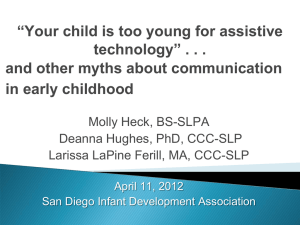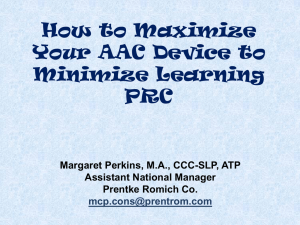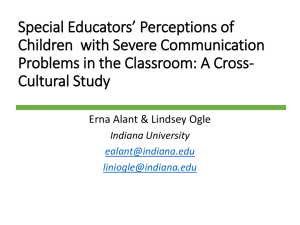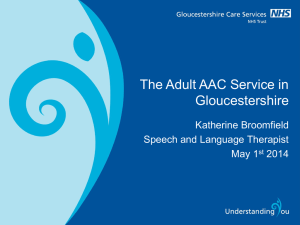AAC Interventions for Individuals with Acquired Disabilities
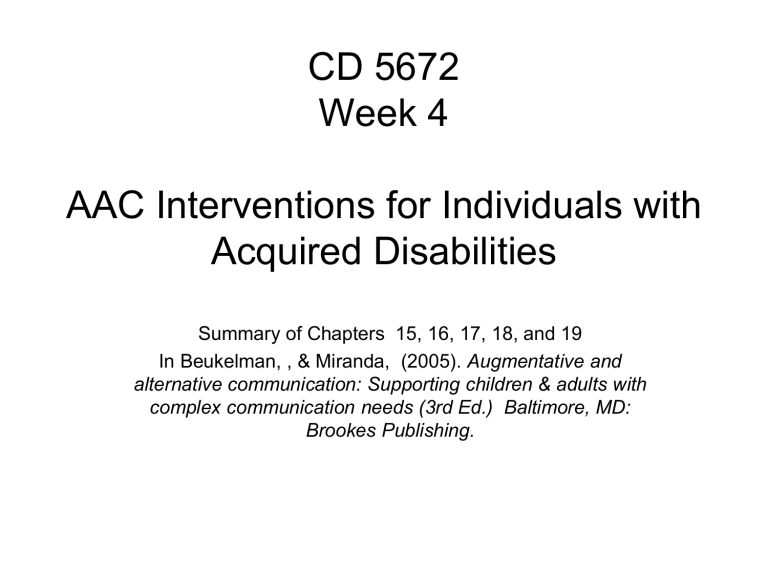
CD 5672
Week 4
AAC Interventions for Individuals with
Acquired Disabilities
Summary of Chapters 15, 16, 17, 18, and 19
In Beukelman, , & Miranda, (2005). Augmentative and alternative communication: Supporting children & adults with complex communication needs (3rd Ed.) Baltimore, MD:
Brookes Publishing.
Chapter 15
Adults With Acquired
Physical Disabilities
Model for Intervention
• Communication needs can be based on several factors.
The three reasons to measure the intervention outcomes are:
1. To consider the outcomes that have and have not been met.
2. To document the effectiveness of the AAC agency and services provided.
3. To measure the effectiveness of the agencies efforts.
Acquired Physical Disabilities
• Amyotrophic Lateral Sclerosis (ALS)
• Multiple Sclerosis
• Guillain- Barre Syndrome
• Parkinson’s Disease
• Brain- Stem Stroke
AMYOTHROPHIC LATERAL
SCLEROSIS
• Average onset is age 56
• ALS affects the motor neurons of the brain and spinal cord, there is an unknown etiology
• Persons with ALS maintain their cognitive abilities throughout the prognosis, however, there are changes in cognition with their executive functioning skills.
• 14%-39% survive for five years after being diagnosed.
• 10% live up to ten years
• Median survival rate is 2.2 years
• Persons with dementia and ALS will also have more severe problems including severe personality changes and more cognitive breakdowns.
Communication Symptoms of ALS
• Between 75% and 95% of people with ALS are unable to speak at the time of their deaths.
• Depending on the progression and type, speech symptoms can vary
• Flaccid-spastic dysarthria are almost universally present at some point
• Speech rate may decrease but intelligibility does not until speech rate decreases to less that 100 words per minute
Cognitive/Linguistic Skills
• People with ALS generally retain cognitive and linguistic function with progression.
• 40%-50% of those with ALS experience some degree of dementia.
• 25%-35% of those without diagnosed dementia will experience subtle changes in cognition.
• Cognitive deficits tend to be more prominent in individuals with dysarthria and pseudobulbar palsy.
• Evidence shows that progressive aphasia tends to evolve into individuals with ALS.
Motor Skills
• Motor control capabilities effect AAC systems
• Bulbar ALS
– For some time people with this type can usually use a device that they can touch with their fingers or hands.
• Spinal ALS
– These persons will typically have limb and trunk weakness so they will need a device that involves scanning of some type. During the progression the need to change the device will occur several times.
AAC Devices & ALS
• Typically persons with ALS are open to AAC systems but it is important to assess their acceptance of the system for best use.
• Early introduction to AAC is key.
• If implemented after speech is lost, instruction on how to operate a device becomes much more challenging.
• An individual may always need facilitator assistance to help maintain the device.
Intervention Staging
• Each stage relies more and more on AAC than the preceding stage.
Stage 1: Minimal to no detectible speech disorder, may be short, purpose of intervention is to monitor speech, educate individuals with ALS, and acceptance of disease.
Stage 2: Changes in speech rate due to fatigue, focus intervention on minimizing environmental interference, teaching strategies for establishing conversational topics, making sure listeners are understanding of the message, group conversations.
Intervention cont.
• Stage 3: decrease in intelligibility, intervention should focus on slowing speech rate to compensate, AAC device needs to be learned and available to resolve communication breakdowns.
• Stage 4: AAC devices become the primary source of communication along with residual natural speech.
• Stage 5: loss of all functional speech and rely on
AAC entirely, ventilators may be used for respiratory support, swallowing difficulties may occur.
MULTIPLE SCLEROSIS
• MS is a degenerative disease where there is multiple plaques that cause destruction in myelin cells.
• Dysarthria is the most common among MS but is not present in all persons.
Although there are speech impairments, for most persons, AAC systems are not required.
• Aphasia can also be associated with MS causing language impairments at different degrees for different people.
• Visual impairment is also affected with MS, often being one of the first symptoms.
• Motor control problems vary significantly depending on the person and progression. The limitations of MS that will be acquired must be assessed with visual impairments when assessing for an AAC device.
• Since progression is unknown it is hard to locate a device that will work for long periods of time and assessment is difficult for the same reason.
The 5 classes of MS
1.
Relapse and remitting- a person will have symptoms and fully recover.
2.
Chronic progressive- the symptoms progress over time becoming more severe.
3.
Combined relapse/remitting with chronic progressive- degeneration of capabilities with times of remittance.
4.
Benign- typical life span with little progression and typical functioning.
5. Malignant- rapid deterioration of the cognitive, cerebellar, and pyramidal systems that leads to death in a short amount of time.
Intervention Staging
Stage 1: No detectible Speech Disorder, intervention should include education about progression
Stage 2: Slight changes to speech, unstable volume, and speech intervention is not recommended yet.
Stage 3: Dysarthria appears and effects intelligible speech, intervention is not required but recommended to teach breakdown resolution strategies.
Intervention Staging cont.
Stage 4: Experiencing significant reduction in intelligibility, intervention includes speaking in optimal listening conditions, alphabet boards are commonly used during this stage.
Stage 5: Limited functional speech, rely on AAC device for communication, implement yes/no communication systems with caregivers, individualized interventions are necessary.
GUILLAIN-BARRE SYNDROME
• GBS is a degenerative disease that is characterized by progressive destruction and regeneration of myelin sheaths in the peripheral nervous axons.
• Paralysis begins in legs and moves upwards.
• Paralysis lasts from one to three weeks and the myelin sheath regenerates and muscle strength slowly returns, starting with the head.
• 80% fully recover.
Communication Disorders
• Flaccid dysarthria
• Anarthria (complete loss of speech)
• Severe paralysis requires ventilator support
• Language and cognition is usually unaffected.
Intervention Stages
Stage 1: monitor progression so AAC can be provided when appropriate
Stage 2: respiratory support and AAC intervention is needed, develop yes/ no system
Stage 3: continue to use low-tech AAC devices
Stage 4: regain speech with reduced intelligibility and loudness, continued respiratory support
Stage 5: residual weakness, occasionally dysarthria
PARKINSON’S DISEASE
• PD is caused by a loss of neurons in the basil ganglia and brain stem. This causes many motor problems for the person.
• Persons with PD typically have the ability to spell words out for a device, but can have training to help with memory and learning difficulties.
• Sensory skills are left unchanged.
• Side effects of L-dopa can interfere with AAC approaches
• Motor symptoms include: resting tremor, rigidity, reduction of movement (paucity), and impaired postural reflexes
Communication Symptoms
• Dysarthria and dementia
• Speech symptoms include reduced pitch, volume, increased rate, reduced intensity, imprecise articulation
• No natural course of symptoms
• Gradually become increasingly difficult to understand
Motor Skills
• AAC interventions should be aware of their progressive motor impairments and create the device accordingly
• Due to reduced ROM and speech, AAC devices need to have a smaller display, size, and keyguard for excessive movement
• Lack of fine motor control will limit AAC options
Assess Constraints
• Due to slow progression, people with PD may be hesitant to use an AAC device because at the time of onset, they can speak
• People with PD have older peers and who could have a poorer hearing, which would cause a communication barrier
• People with PD blame the communicaiton partner for not being understood
Intervention Stages
Stage 1: no speech difficulties, education and acceptance of family, peers, and person diagnosed
Stage 2: reduce volume, speech intervention recommended, portable speech amplification systems may improve communication
Stage 3: reduced intelligibility, reduced loudness, increased rate, important to have frequent communication partners to become more familiar to speech
Intervention Stages cont.
Stage 4: no functional natural speech, AAC boards can include pace setting boards, alphabet supplementation to control speaking rate.
Stage 5: loss of all functional speech, overall motor control and cognitive impairments,
AAC devices are difficult to implement and intervention is very individualized.
BRAIN STEM STROKE
• BSS is caused by lack of circulation around the brainstem often causing dysarthria or anarthria.
• Persons with BSS’s communication symptoms differ considerably depending on the level of disruption and dysarthria.
• Tactile impairments typically occur with BSS
• Vision problems may or may not be affected; eye problems may be affected if the stroke is high in the brain stem.
Communication/Linguistic and
Sensory/ Perceptual Skills
• If the stroke only involves the brain stem, no cognitive or language impairment is expected.
• If the stroke affects more than the brain stem, cognitive or language impairments may occur.
• Usually no cognitive impairments
Motor Skills
• Usually experience problems with limbs.
• Difficulty controlling speech mechanisms which would effect articulation and intelligibility.
• Research shows eye or head pointing as the alternative access mode is successful as an AAC system.
Intervention Stages
• Since BSS not degenerative, the stages go from worse to better in terms of therapy
Stage 1: provide early communication system so they can at least answer yes/no questions
Phase 1- Initial choice making
Phase 2- Pointing
Phase 3- Multipurpose Electronic AAC device
Stage 2: develop voluntary control of respiratory, vocal, velopharyngeal, and articulatory systems while continuing to use AAC systems
Intervention Stages
Stage 3: intervention focuses on intelligibility with goals of meeting all communication needs through natural speech
Stage 4: no need for AAC device, goal of intervention is to speak as natural as possible by learning appropriate breath groups and stress patterns
Stage 5: no detectable speech disorder, very uncommon
Locked- in- Syndrome (LIS)
• Similar to BSS
• A basilar artery stroke, tumor, or trauma that results in damage to the upper pons and occasionally the midbrain causes a conscious quadraplegic state that limits voluntary movements to vertical eye movements and sometimes eye blinks.
• Average survival rate of 85% is 5 years, ranging from 2 to 18.
• Low and high-tech AAC devices can be implemented.
• Angie H… refer back to printed ppts for revision of this ppt…..
Chapter 16
Adults with Severe Aphasia
Aphasia
• “Aphasia is an impairment of the ability to interpret and formulate language” (Garrett & Lasker, 2005, p. 467).
– Reduced abilities in speaking, auditory comprehension, reading, writing, and gestural communication
• Approximately 1 out of every 275 adults in the United
States have aphasia (Garrett & Lasker, 2005).
• Most commonly results from Cerebral Vascular
Accident (CVA)
• Other etiologies include: brain injury related to accidents, tumors, or neurologic illnesses
Subtypes of Aphasia
• Wernicke’s
• Broca’s
• Transcortical
• Anomic
• Global
Treatment Approaches
• Traditional treatment involves assisting people with aphasia to speak more effectively, comprehend more fully, and write with fewer errors
• Participation Model focuses on interventions that enhance the person with aphasia’s ability to actively participate in life activities that are important to them –
Patients are encouraged to use natural communication modalities and AAC
Functions of Communiation
– Analyze the purposes of communication prior to designing
AAC interventions
– Consider the four general functional categories: expression of basic needs and wants, information transfer, social closeness, and social etiquette
Partner Dependent Communicators
• These communicators will always be dependent on their conversational partners for informational demands and communication choices within familiar contexts
• Emerging Communicator
• Contextual Choice Communicator
• Transitional Communicator
Emerging Communicator
– Characteristics
• Profound cognitive-linguistic disorder across modalities
• Extreme difficulties speaking, using symbols, and responding to conversational input
• Seldom communicate purposefully or use nonverbal signs, such as pointing or nodding
– Intervention Strategies for Emerging Communicators
• May initially benefit from contextual activities that elicit referential skills
• Low-tech AAC devices can be used to help the emerging communicator comprehend and control their environment
• Treatment is focused on foundational communication skills: turntaking, choice-making ability with tangible objects or photographs, referential skills, and clear signals of agreement or rejection
• Conversation partner training should focus on how to provide choice-making opportunities throughout daily routines and reinforce communicator’s responses
Contextual Choice Communicator
– Characteristics
• More capable than emerging communicators, but do not initiate or add to conversations on their own – socially isolated
• Can participate in conversations when provided written or pictorial choices on a turn-by-turn basis
• May benefit from Augmented Input Techniques
– Intervention Strategies for Contextual Choice
Communicator
• AAC interventions should be embedded within conversations about familiar topics
• Primary expressive goal is to teach the communicator to consistently reference what he or she is talking about, understand the meaning of graphic symbols, make choices to answer questions, and begin to ask questions by pointing
Strategies for Contextual Choice
– Written Choice Conversation – the facilitator generates written key words that are pertinent to a conversational topic.
Reponses can be general or specific.
– Yes/No Responses to a Partner’s Tagged Questions – Partners add the phrase “yes or no” at the end of their questions coupled with the corresponding head nod or shake.
– Asking Questions – May need additional interventions to initiate conversations, such as hand-over-hand assistance to point or gesture toward something or someone to ask questions
– Augmented Comprehension (Input) Techniques – especially for the communicator with aphasia who also has auditory processing difficulties: after the communication partner identifies that the person with aphasia has misunderstood, partner reiterates the message while simultaneously pointing to the item being discussed, showing photographs, writing key words or phrases, etc.
Transitional Communicators
– Characteristics
• Have strategies to convey their message when they are unable to speak, such as search through their communication notebooks or gesturing.
• Biggest challenge is communicating successfully in spontaneous conversations without contextual cues
– Intervention Strategies for Transitional
Communicators
• Focus is on initiating conversations with as little cueing as possible
• Storytelling can be used as a content-rich communication activity
Independent Communicator
• Can comprehend most of what is said to them without contextual support; use both natural speech and augmented strategies
• Stored Message Communicators
• Generative Message Communicators
• Specific Need Communicators
Stored Message Communicators
– Characteristics
• Can independently locate messages that have been stored in their AAC systems, without prompting in familiar settings
• Seldom generate novel information in unusual topics (AAC skills too limited to participate independently in free-form conversations)
– Intervention Strategies for Stored Message
Communicators
• Therapists and family members should work together to store an inventory of messages for specific situations.
• Intervention sessions outside of the therapy room, in naturalistic settings, may be helpful to evaluate the effectiveness of message content, etc.
Generative Message
Communicator
– Characteristics
• Maintain independent lifestyles
• Preserved skills may include drawing, gestures, pantomiming, first-letter-of-word spelling, word writing, and pointing to words or symbols
• Communication skills are often fragmented or inconsistent and require some AAC intervention
– Intervention Strategies for Generative
Communicators
• Focus on participation patterns, clarifying communication needs, identify topics of interest, and teach the individual to manage a variety of AAC strategies
• Teach the generative message communicator when to use the various AAC strategies – often overlooked
Specific Need Communicator
– Characteristics
• These communicators only need AAC in certain situations for specificity, clarity, or efficiency
• Often live independent lifestyles
– Intervention Strategies for Specific-Need
Communicators
• Analyze the requirements of the specific communication task and contrast those requirements with the communicators current skills
• May benefit from situation training (role play)
Assessment
– Evaluate communication needs, linguistic and cognitive competencies
– Assess communication needs in real-life contexts
– Assess Specific Capabilities
– Linguistic Skills
– AAC-Related Skills
– Nonverbal Communication Skills
– Motor Skills
Assessment cont.
• Sensory Skills
• Perceptual Skills
• Pragmatic Skills
• Experiential Skills
• Cognitive Skills
• Assess Constraints
• Partner Skills
Demands of Potential AAC
Strategies
• Motoric
–
Writing, pointing, access to digitally stored messages
• Cognitive
–
Must memorize symbols (if used)
– more novel than words
–
Numeric coding
– Layers of arrays or boards – remember to look on each and the steps to transition between, as well as where things are located without having it represented in front of them
– Spelling
• Operational skills
–
Turning the device on/off, comprehending synthesized speech, using flowchart menus, keyboarding, charging the device
• Metacognitive
–
Using speech and writing, knowing when to use other strategies
–
Knowing when to rephrase a message as opposed to repeating
– Repairing communication breakdowns with various AAC strategies
• Linguistic
–
Syntax & word-retrieval
Intervention Issues
– The following may affect success of an AAC intervention. This is not an exhaustive list:
• The individual's or family's continued desire to work on speech
•
•
•
•
•
•
•
Difficulty with acceptance of AAC alternatives
Premature discontinuation of treatment
Poor matching between AAC system features and communicator's capabilities
Limited availability of personalized messages
Lack of practice in contextual situations
Lack of available communication partners for partner-supported communicators
An inadequate support network to assist in message development for generative communicators
• Lack of communication opportunities because needs are anticipated by others
– Clinicians can work with the communicator and family members about their hesitations using a device
– Emphasis on conversation partner training should occur early in an individual's recovery
– Schedule routine follow-up visits each week, if possible
Chapter 17
Primary Progressive Aphasia
Primary Progressive Aphasia
• PPA is characterized by a gradual regression/deterioration of language skills in the absence of other types of cognitive impairments or other behavioral disturbances for a period of at least two years.
• PPA is the fifth most common type of dementia
• Some individuals with PPA may eventually show other cognitive impairments that are more consistent with other types of dementia (such as Alzheimer’s disease)
• Symptoms of PPA include:
– anomia (problems with naming)
– slow and hesitant speech
– fluent and nonfluent forms exist
Early Stage Intervention
• People in early stages of PPA are still able to use some speech
• People in the early stages show the most difficulty with word finding
• Intervention techniques are similar to techniques used for “specific needs communicators”
– use of booklets or cards that contain specific information
– pre-prepared questions that can be used for tricky language situations
• gestures for resolving communication breakdown
Middle Stage Intervention
– People with PPA in this stage are considered “generative message” or “transitional” communicators
– People in this stage may require AAC for most communicative contexts
– Persons in this stage may benefit from drawing in order to communicate messages
– Persons in this stage may find the use of: maps, calendars, floor plans to be helpful for the clarification of specific content related to their messages
– Persons in this stage may also have problems comprehending spoken information and so may require some augmented input devices as well as devices/strategies for message generation, these might include: printed key words, photos, gestures, etc.
Late Stage Intervention
– The communication needs of persons with PPA in the late stages are similar to the needs of
“contextual choice communicators” in the initial phases of this stage
– These individuals need help both to communicate and to comprehend information
– As the disease progresses, these persons may become “emergent communicators”. At this time, they may require the use of interventions which use limited choice making for the communication of needs and wants
Communication Notebooks
– Communication notebooks are small wallets or note-books which contain information that is personalized relevant to a person’s communication needs
– Communication notebooks or wallets may contain:
• photos of family members
• if literate, may contain printed info that the person may normally forget
• Notebooks should be personalized
• Person with dementia or PPA should help the SLP decide what content will be placed in the notebook before the disease progresses
• Opportunities for using the note-book and updating of content should be a priority throughout the course of PPA
• The notebook should be dynamic and adapted as the individual’s communication needs change
Dementia
– Dementia is described as a chronic, acquired cognitive impairment
– Diagnosis requires that the cognitive impairments involve: memory PLUS one other cognitive domain which might include: attention, language, praxia, and frontal lobe functions, Alzheimer’s is the most common form
– Dementia affects:
• episodic memory- memory of recent events, effected first
• semantic memory- memory for facts and general knowledge
• procedural memory- memory for how to do things, this type of memory is preserved the longest
AAC Recommendations for
Dementia
– The primary focus of intervention throughout the course of the disease is focus on strengths of the individual
– General communication strategies for persons with dementia:
• Use of memory books (facilitates memory by utilizing recognition rather than recall memory)
• Reducing distractions- Persons with dementia may process information more easily in distraction free environments
• Organize information into manageable “chunks”
• Provide information in multiple modalities (visual, auditory, etc)
• Strategies should address both language representation and organization
• Environmental print/photos- when placed on commonly used items, may remind person what the items are used for
• Use a variety of strategies
Huntington’s disease
Huntington’s disease
HD is an inherited autosomal dominant degenerative disease.
• Symptoms begin to appear around age 40
• Persons with HD are often unable to speak functionally by the end stages of disease (Folstein, 1990)
• Primary symptoms include:
– spastic/irregular movement of the limbs/face
– emotional problems
– cognitive symptoms progressing to dementia with time
• Communication impairments include:
– language comprehension deficits including high-level processing difficulties
– expressive language deficits
AAC Strategies for HD
• Speech may or may not be so impaired that it requires
AAC, dependent on stage of disease and individual variation
• Literature review suggests limited success with high-tech
AAC for persons with HD, as reported by Beukelman
(2003)
• Text suggests low-tech AAC strategies that focus on schedules and choice-making early in the course of disease
• Other suggestions include training communication partners to cue/prompt persons using AAC consistently
• Linguistic and cognitive supplementation is also recommended (such as to-do lists, note-books describing daily activities)
Chapter 18
Traumatic Brain Injury
TBI
• Until the mid-1990s, patients with TBI only used
AAC devices if they experienced severe, persistent anarthria or dysarthria.
• Intervention with an AAC device is delayed until the communication disorder ‘stabilizes’ after the injury.
• Intervention focuses on short-term needs instead of long-term so the patient can communicate if he/she is in a rehabilitation program.
Prevalence & Etiology
• Many temporary or permanent brain injuries go unreported because the patient may only lose consciousness for a short time and do not go to the emergency room
• 1 in 6 reported TBI cases are unable to return to school or work
• People at risk: between ages of 15-24 years and older than 75 years
• Most common cause is motor vehicle accidents
• Second most common cause is fire arms
Cognitive/ Linguistic &
Communication Disorders
• Impairments in three areas:
– cognitive impairments
– language disorders
– communication disorders as a result of damage to the motor control networks
• The communication disorder can change greatly over the period of recovery
Natural Ability Interventions
• SLPs are not able to predict if the patient will have natural speech recovery
• Topic Supplementation
• Alphabet Supplementation
• Portable Voice Amplification
Topic Supplementation
• If the patient’s speech is slightly intelligible, a communication device that provides context or a topic may be helpful.
Alphabet Supplementation
• Used for patients with dysarthria
• The first letter of each word is pointed to on an alphabet board while saying the word
• Allows the listener to focus on words that begin with the letter
Portable Voice Amplification
• Some patients with dysarthria speech is very quiet , therefore a portable speech amplifier may be used
Assessment & Intervention
• Early Stage (Levels I, II, and III)
• Assessment
– Very difficult to assess because the patient may not be able to stay awake or pay attention for a long period of time.
– Very little formal assessment is used during this stage
– The team documents changes and observations of the patient’s responses
– Gradually the person is able to differentiate between two or more people or object-good sign of development of yes/no responses
• Intervention
– The first goal is to have the person awake and responding to simple commands consistently.
Assessment & Intervention cont.
•
•
• Middle Stage (Levels IV and V)
–
–
–
–
–
–
–
–
Assessment
The patient will begin to specify his/her basic needs
May have a difficult time accepting the AAC intervention at this time because of agitation and poor awareness of his/her communication deficits
At this time assessment is used to determine what the individual can do to help achieve communication goals
This assessment is informal and nonstandardized
•
Seating and positioning is the main concern at this point
This is important to determine if the patient can use direct selection or scanning options.
AAC Intervention
One or two major communication goals should be chosen at this time
The devices include nonelectronic: alphabet boards, pictures, word boards, yes/no techniques, and dependent scanning
Communication partners are important at this stage
Assessment & Intervention cont.
• Late Stages (Levels VI, VII, and VII)
• Assessment
– Most individuals at this point have regained the cognitive capability to be a natural speaker
– Those who cannot speak- due to motor control disorders or severe specific language disorders
• AAC Intervention
– May have a difficult time learning new information
– Natural speech usually has already come back before this stage
– AAC techniques in this stage are used for patients who have physical or cognitive impairments.
– The most important skill to regain is reading and spelling
Chapter 19
AAC in Intensive and Acute
Medical Settings
Intensive & Acute Medical Settings
• Acute and intensive medical units serve a wide range of individuals who are unable to communicate, either temporarily or permanently.
• Communication problems in these settings often occur as a result of primary medical conditions such as: traumatic brain injury, stroke, oral-laryngeal cancer, etc. or as a side effect of interventions such as surgery, intubation, and/or tracheostomy.
• People in acute settings need to communicate regularly with hospital staff in order to participate in their own care, as well as with family members.
Causes of Communication
Disorders in Acute Medical Settings
• CD in acute medical settings can occur as a result of both primary causes and secondary causes
• Respiratory support often interferes with communication processes and a persona’s ability to speak.
• Primary Causes- those directly related to an individual’s illness or condition
• Secondary Causes- those related to an individual’s need for temporary respiratory support
Endotracheal Intubation
• Designed to transport air from a ventilator to an individual’s respiratory system.
• Endotracheal tubes are usually passed in emergency situations through the person’s mouth, pharynx, and larynx into the trachea.
• Oral intubation interferes with communication in several ways.
– First, because the endotracheal tube passes through the oral cavity, it is impossible to articulate speech accurately.
– Second, because the endotracheal tube passes between the vocal folds, which are located in the larynx, it is impossible to produce sound.
Tracheostomy
• A tracheostomy is another way to transport air from a ventilator to an individual’s respiratory system.
• It is a surgical opening from the front wall of the lower neck into the trachea.
• An individual with a tracheostomy tube who depends on a ventilator has limited natural speech because air passes from the ventilator through the tube, rather than through the oral cavity and past the vocal folds.
• Air passes in and out of the trachea via the tracheostomy tube, bypassing the vocal folds so that no phonation is possible and messages must be mouthed.
AAC Service Delivery in Acute
Medical Settings
• The core AAC team generally includes a speech-language pathologist, a physical therapist, and an occupational therapist who are employed by the hospital.
Establishing an AAC Program
• The following equipment and materials should form the basis for AAC interventions in acute medical settings:
– a lightweight neck-type electrolarynx
– an oral-type electrolarynx
– materials to construct alphabet boards, word boards, and picture boards
– several magic slates
– a portable mounting system on wheels to hold cardboard message boards or eye-pointing displays
Barriers and Supports
• AAC teams must deal with a number of practice or knowledge barriers including:
– Medical teams that do not refer individuals for
AAC services
– Personnel who prefer not to be burdened with additional work in an already busy workplace
– Speech-language pathologists and other professionals who are not familiar with conducting AAC interventions in these settings.
Screening
• The AAC team should conduct a preliminary screening as the first step of an assessment to determine whether the individual is an appropriate candidate for a more complete evaluation.
• The individual must be able to follow simple directions and have some way of indicating yes and no.
• Individuals who successfully complete preliminary screening tasks undergo a more extensive assessment of their capabilities.
People with Sufficient Oral-Motor
Control for Speech
• The first step in evaluation should be assessment of oral-motor capabilities.
– If these are adequate to support speech, assessors should explore oral communication options.
– If oral-motor control is inadequate, assessors must explore other communication options.
• People that may not have the motor control necessary to produce voicing will need one of two types of electrolarynx often serves as an effective intervention device.
– A “ neck-type ” electrolarynx is positioned against the exterior neck wall and vibrates the air column within the vocal tract.
– An oral-type electrolarynx delivers sound into the oral cavity through a tube or catheter.
• The oral-type electrolarynx is useful for individuals who can’t use a necktype due to extensive tissue damage, swelling, or surgical tenderness in the neck area or because they must wear cervical collars that obscure their necks
Individuals with Insufficient Oral-
Motor Control for Speech
• Writing Options :
– handwriting
– self construction of communication book
– “magic” slate so they can erase messages
• Options for People who cannot write :
– pointing with hands, eyes, or head to use direct selection
– alphabet board
– small typing system (individuals in an acute setting are unlikely to have the time or motivation to use an encoding strategy)
– voice output if possible ( “voice banking” for children)
• Options for People who Cannot use Direct Selection :
– scanning options: dependent and independent
Access Constraints
• Funding : Fortunately, the same resources that are responsible for hospitalization fees usually fund all medicare-related services, including AAC services.
• Instruction of Listeners : The short-term acute medical environment imposes quite extensive learning constraints.
– First, individuals are very ill and under a considerable amount of stress.
– Second, many professionals and others interact with these individuals over the course of their stay.
– The most effective AAC interventions are those that require minimal listener training. Individuals and their medical teams tend not to use complicated AAC systems in short-term acute medical environments



